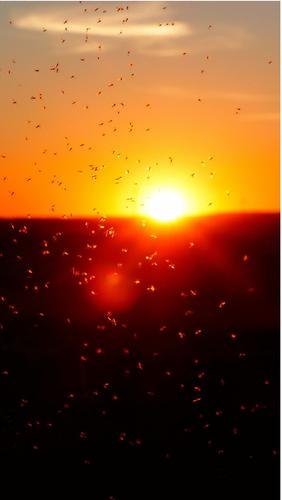The European Physical Journal E ( IF 1.8 ) Pub Date : 2021-03-08 , DOI: 10.1140/epje/s10189-021-00040-x Andy M Reynolds 1

|
Abstract
Intrinsic stochasticity associated with finite population size is fundamental to the emergence of collective behaviours in insect swarms. It has been assumed that this intrinsic stochasticity is purely additive (position independent) in quiescent (unperturbed) swarms. Here, I identify the hallmarks of intrinsic multiplicative (position dependent) stochasticity and show that they are evident in quiescent laboratory swarms of the non-biting midge Chironomus riparius. In accordance with theoretical expectations, the smallest well-documented laboratory swarms (containing between 14 and 46 individuals) are found to have q-Gaussian density profiles with \(q>\) 1, whereas larger laboratory swarms have Gaussian (\(q=\)1) density profiles. I show that these newly identified states are analogous to interstellar clouds and thereby extend a long-standing analogy between insect swarms and self-gravitating systems. Smaller laboratory swarms have been observed and are predicted to be gas-like, filling the available space rather than occupying just a small proportion of it. The new results unify laboratory swarms with wild swarms. Unlike laboratory swarms, wild swarms must contend with environmental (extrinsic) noise and have density profiles that are accurately represented by q-Gaussians with \(q<\) 1. Finally, it is shown how intrinsic multiplicative noise allows for the nucleation of swarms away from prominent visual features (basins of attraction) known as swarm markers.
Graphic abstract
中文翻译:

昆虫群中的内在随机性和集体行为的出现
摘要
与有限种群规模相关的内在随机性是昆虫群中集体行为出现的基础。已经假设这种内在随机性在静止(未受干扰)群中纯粹是可加性的(位置无关)。在这里,我确定了内在乘法(位置相关)随机性的特征,并表明它们在不咬人的河岸摇蚊的静止实验室群中很明显。根据理论预期,发现最小的有据可查的实验室群体(包含 14 到 46 个个体)具有q -高斯密度分布,\(q>\) 1,而较大的实验室群体具有高斯分布 ( \(q= \)1) 密度剖面。我展示了这些新发现的状态类似于星际云,从而扩展了昆虫群和自引力系统之间长期存在的类比。已经观察到较小的实验室群,预计它们会像气体一样,充满可用空间,而不是只占据其中的一小部分。新结果将实验室群体与野生群体统一起来。与实验室群体不同,野生群体必须与环境(外在)噪声抗衡,并且具有由q -Gaussians 和\(q<\) 1准确表示的密度分布。 最后,它展示了内在乘法噪声如何允许群体成核远离被称为群体标记的突出视觉特征(吸引力盆地)。



























 京公网安备 11010802027423号
京公网安备 11010802027423号